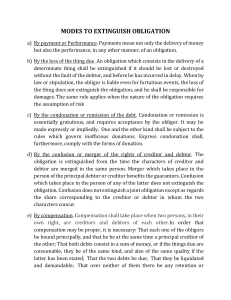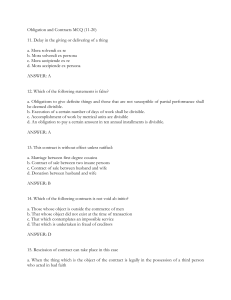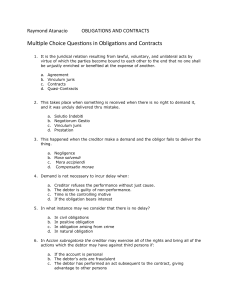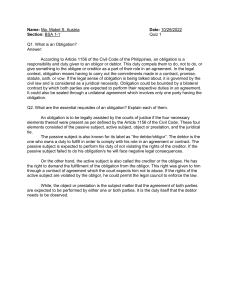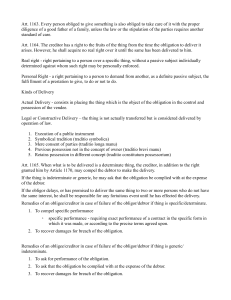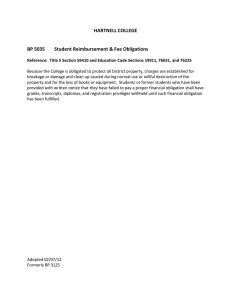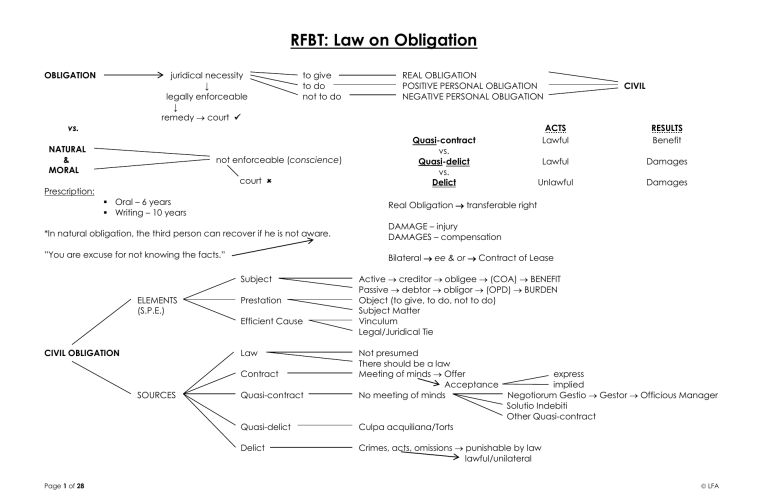
RFBT: Law on Obligation OBLIGATION juridical necessity ↓ legally enforceable ↓ remedy court vs. NATURAL & MORAL to give to do not to do not enforceable (conscience) court Prescription: Oral – 6 years Writing – 10 years REAL OBLIGATION POSITIVE PERSONAL OBLIGATION NEGATIVE PERSONAL OBLIGATION Quasi-contract vs. Quasi-delict vs. Delict ACTS Lawful RESULTS Benefit Lawful Damages Unlawful Damages Real Obligation transferable right *In natural obligation, the third person can recover if he is not aware. DAMAGE – injury DAMAGES – compensation ”You are excuse for not knowing the facts.” Bilateral ee & or Contract of Lease Subject ELEMENTS (S.P.E.) Prestation Efficient Cause CIVIL OBLIGATION Law Page 1 of 28 Active creditor obligee (COA) BENEFIT Passive debtor obligor (OPD) BURDEN Object (to give, to do, not to do) Subject Matter Vinculum Legal/Juridical Tie Quasi-contract Not presumed There should be a law Meeting of minds Offer Acceptance No meeting of minds Quasi-delict Culpa acquiliana/Torts Delict Crimes, acts, omissions punishable by law lawful/unilateral Contract SOURCES CIVIL express implied Negotiorum Gestio Gestor Officious Manager Solutio Indebiti Other Quasi-contract LFA DELICT crime PP vs. Accused A if Convicted Criminal Liability = imprisonment Civil Liability = damages Acquitted Criminal Liability = guilt without reasonable doubt = guilt with reasonable doubt = Civil Liability POSITIVE To give REAL delivery object ↓ certain 1. Determinate = Specific (particularly designated/physically segregated) 2. Indeterminate = Generic (cannot be pointed out with particularity) B only cow = DETERMINATE C a horse = INDETERMINATE D four legged animals = INDETERMINABLE A to give B demands delivery Deliver = obligation extinguished A Court A to Fails B or To require another to deliver = 2 RIGHTS REAL – enforceable against the whole world PERSONAL – enforceable against another person “All owners can possess, but possessors are not all owners.” deliver specific performance & pay damages = delay C demands delivery Deliver A Fails C To do obligation extinguish neither court to require A to or to require another to deliver Positive Personal Superior Inferior = obligation extinguish deliver specific performance & pay damages = delay LAW Law Source Contract A Reg. of Deeds ↓ record Obli. to transfer S sells land to B Title – Name – S B demands transfer of title title land Transfer Title Name B Obligation = Extinguished A Fails B Court To require A to transfer Title Specific performance (mandamus) Page 2 of 28 LFA A to paint B portrait. B demands fulfillment. Paints Obligation = Extinguish A Done Fails B Court to require A to or To require another to paint properly = obligation extinguish poorly = should be undone at the expense of A paint = specific performance damages breach of contract 1. As required by law 2. As stipulated by parties 3. Absence of #1 and #2, diligence of a good father of a family = ordinary diligence DILIGENCE Carriage Carrier Law – utmost care = extraordinary diligence Agency ↓ (extension of the principal) Agent Law A good father of a family ↓ Stipulation Extraordinary Diligence – Valid Performance Duty Innately attached Improvements (BEC) Stipulation = a good father of a family = void Transport passenger Better use = convenience Embellishment = beautification Completion To give determinate accessions & accessories even if not mention To give determinate fruits KIND (NIC) Natural – spontaneous product Industrial – cultivation/labor Civil – juridical relation RIGHT (unilateral) A to give B only cow on May 10, 2017 – due Obligation Extinguish Ordinary Delay Page 3 of 28 Creditor Debtor determinable dies lightning F.E. no one is liable with exceptions June 1, 2017 no delay VALID – according to law VOID – in existence of null – against the law *“No one is above the law” Unconscionable = shocking to the conscience Right ≠ Ownership B right to demand If B demand A = legal delay liable did not = “no demand, no delay” time obligation to deliver arises when? suspensive condition condition fulfilled With suspensive period period arrives Obligation Condition Pure/Simple PERFECTION Period LFA SPECIFIC CIRCUMSTANCES AFFECTING OBLIGATIONS IN GENERAL 1. FORTUITOUS EVENT cannot be foreseen foreseeable are inevitable ESSENTIAL CHARACTERISTICS Cause is dependent of the will of the debtor Unforeseeable or unavoidable Impossible for the debtor to fulfill the obligation in normal manner The debtor must be free from any participation in aggravation to the creditor GENERAL RULE: No person shall be liable for fortuitous events. (Obligation Extinguished) EXCEPTIONS: When Expressly declared by the law Expressly declared by stipulation The nature of the obligation requires the assumption of risk The debtor has incurred delay/guilty of fraud/negligence/breach of contract The debtor promised to deliver the same thing to two or more persons who do not have the same interest The thing to deliver is indeterminate/generic The obligation to deliver a specific thing arises from crime The bailee in commodatum allows third person to use the thing borrowed 2. FRAUD (or Dolo) deliberate or intentional evasion must be present during the performance of the obligation not fraud at the time of the birth of the obligation Liable: direct & foreseeable Dolo Causante Causal Fraud Vitiating consent / obtaining consent Consent would not have been given The contract is voidable Committed at the time of performance or after the contract is already perfected KINDS OF FRAUD Dolo Incidente Incidental Fraud Giving rise to the right to demand damages Consent would have still been given The contract is valid Committed at the time of performance or after the contract is already perfected Page 4 of 28 LFA Future Fraud Cannot be renounced Waiver cannot be made void the debtor is liable for damages Past Fraud Can be renounced Waiver may be made valid act of liberality of creditor 3. NEGLIGENCE (or Culpa) Omission of that diligence Master-Servant Rule: The negligence of the servant is the negligence of the master. Test: Diligence of a good father of a family Liable: Direct consequence Source: Contract Example: Breach of Contract of Carriage (Even with the supervision, the employer may mitigate the liability) Performance of contract The master-servant rule applies CULPA CONTRACTUAL (Contractual Negligence) KINDS OF NEGLIGENCE (or Culpa) Source: Quasi-delict Example: Reckless driving of the driver (With the supervision, the employer may escape the liability) Independence of contract & without criminal intent The master-servant rule does not apply Culpa extra-contractual CULPA AQUILIANA (Civil Negligence) Source: Delict Example: Physical injuries through reckless imprudence (The employee‟s guilt is automatically the employer‟s guilt if the former is insolvent) Commission of a crime CULPA CRIMINAL (Criminal Negligence) EXAMPLE: A Contractual A – Driver B – Passenger C – Pedestrian Y - Operator Y A A Aquiliana Y F Demandable? N Responsibility Criminal Y *COMMON CARRIER presumed to be negligence Page 5 of 28 LFA 4. DELAY (or Mora) Nonfulfillment of obligation with respect to time Effect of Delay: Liable for payment of damages Note: There is no delay in „obligation not do‟ as one cannot be delay for not doing something General Rule: “No demand, no delay” (1) (2) (3) (4) (5) (6) EXCEPTIONS (to the General Rule) The law expressly so declares (e.g. Such in the case of taxes) The obligation itself so stipulates (Expressly declares: “without need of demand”) Time is of the essence (Time was the controlling motive) Demand is useless (Demandable: Breach of Contract / Dolo / Culpa) When there is performance by a party in reciprocal obligation (Compensatio Morae) DEMAND MORA SOLVENDI Delay on the part of the debtor Ex re real obligation to give Ex persona personal obligation to do MORA ACCIPIENDE Delay on the part of the creditor refuses to accept COMPENSATIO MORAE Delay on both parties (reciprocal obligation) KINDS OF DELAY DAMAGES harm done and sum of money that may be recovered INJURY legal wrong/unlawful/tortuous act KINDS OF DAMAGES Court Receipt Parties RIGHT OF THE CREDITOR AGAINST THE DEBTOR Page 6 of 28 MORAL EXEMPLARY NOMINAL TEMPERATE ACTUAL LIQUIDATED Moral and physical anguish Corrective or to set an example To vindicate right Moderate or exact amount cannot determine Compensatory or actual losses & unrealized profit Predetermined beforehand by agreement Proof is required Proof is not required/ Adjudicated (1) To demand payment or performance (EXACT PAYMENT) To exhaust the property in the possession of the debtor, except those by law (ATTACHMENT) (2) (3) To impugn the acts which the debtor may have done to defraud the creditors (ACCION PAULIANA) (4) To exercise all the rights of the debtor except those personal to him (ACCION SUBROGATORIA) LFA ACCION PAULIANA the right to rescind or impugn fraudulent act the rights to set aside, revoke, or cancel the acts, which the debtor may have done to defraud him. ACCION SUBROGATORIA the right to be subrogated the creditor may exercise in the place of his debtor in order to preserve or recover the property lost or transferred so that he can satisfy his own credit TRANSMISSIBILITY OF RIGHTS GENERAL RULE: All rights acquired by virtue of an obligation are transmissible. (1) When the law prohibits the transfer of rights (2) When the stipulation of the parties prohibits the transfer of rights (3) When the nature of the obligation does not permit transmission of rights EXCEPTIONS (to the General Rule) Note: It is the right of a person that is transmissible not the obligation. The creditor may assign a third person or such right is transmitted to the heirs upon death. KINDS OF OBLIGATION Not subject to any condition No specific date PURE/SIMPLE 1. DEMANDABLE AT ONCE Resolutory Condition Resolutory Period With Yes = Period Will it happen? Maybe = Condition 2. CONDITION Suspensive Resolutory You may demand the delivery of the thing now but you must return it when the condition happened. (1) Future and uncertain (2) Past but unknown (3) Must not be impossible CHARACTERISTICS/REQUISITES OF CONDITION FULFILLMENT Before Upon ― Ext. Contrary CONDITION – not Law Moral Good Custom Public Order Public Practice Impossible Page 7 of 28 LFA SUSPENSIVE PRINCIPAL KINDS OF CONDITION RESOLUTORY POTESTATIVE DEBTOR CREDITOR A ₱8M B If B will Suspensive = VOID Resolutory = VALID Suspensive = VALID Resolutory = VALID POSSIBLE IMPOSSIBLE POSITIVE OTHER KINDS OF CONDITION NEGATIVE POTESTATIVE CASUAL MIXED FULFILLMENT CONDITION Condition subsequent Will extinguish an obligation OBLIGATION CONDITION Kill C = Sex A = Slap faces of parents = Pose nude = ; beside Rizal Monument = Draw rectangle with 4 sides = Draw circle with 4 sides = Not capable of fulfillment, legally or physically = VOID An act is supposed to be performed = TO DO An act is supposed to be omitted = NOT TO DO Will of one of the contracting parties Chance or will of a third person Partly upon chance and will of a third person DEBTOR Suspensive Resolutory (void) (valid) CREDITOR Suspensive Resolutory (valid) (valid) Chance Will third persons (1) WILL One person Third person (2) Will one person Chance MIXED Page 8 of 28 Condition precedent/antecedent Will give rise to an obligation No fulfillment, no obligation CONDITION OBLIGATION Capable of fulfillment, legally or physically POTESTATIVE CASUAL LFA June 8, 2017 A only Horse B If B will pass CPA Before fulfillment condition ― HORSE Obligation = Extinguished B bear loss If B fulfills condition Value Fault of A liable Damages Fortuitous Event B bears impairment Damages Fault of A B Specific Performance By nature B gets improvement Effort of A A ―― right to usufruct Fortuitous Event DIES IMPAIRED IMPROVED June 9 ― B sells horse ― Y pays June 10 ― A sells horse ― W pays deliver October 30 ― B passed 1st day ― October 7 October 6 ―― A ―― food ―― drugs ―― sleep 12 hours ate ―― 9pm wake up ―― 9am ―― October 7 9:01am arrived fulfilled condition 3. OBLIGATION WITH A PERIOD One whose consequences are subjected in one way or another to the expiration of said period/term. It is presumed that the period have been established for the benefit of both the debtor and creditor. CONCEPT SOURCE KINDS OF PERIOD DAY CERTAIN must necessarily come although it may not be known when LEGAL VOLUNTARY JUDICIAL Fixed by law Fixed by parties Fixed by court EX DIE Period with a suspensive effect Demandable upon the lapse of period IN DIEM Period with a resolutory Extinguished upon the lapse of period DEFINITE INDEFINITE A fixed known date or time An event which will necessary happen EFFECT DEFINITENESS Page 9 of 28 PERIOD future and certain event LFA DISTINGUISHMENT 1. As to FULFILLMENT CONDITION May or may not happen PERIOD Must necessarily come 2. As to TIME May refer to the future or to a past event Always refers to the future 3. As to INFLUENCE on the obligation Causes to arise or to cease Merely fixes the time for the efficaciousness of an obligation A ―― ₱100,000 ―― B BENEFIT both Debtor Creditor KINDS Suspensive ― ex die Resolutory ― in diem “when my means permit” = period no means To require A to pay To fix period Court September 30 Change the period A ―― 8M ―― B, if B will marry C 2017 July September October COP B ― vow ― Priest B ― marries Y C dies THE DEBTOR DEPRIVED THE BENEFIT OF PERIOD Obli. A ―― Ext.? Woman Widow remarry 300 days, unless bears a child Man Widower can remarry immediately A ―― ₱100,000 ―― B secured ― race horse due ― June 7, 2018 June 8, 2017 lightning ― frightened Page 10 of 28 Court Parties horse runs cliff fell ― broken A hits horse broken 1. I debtor ― insolvent, except for guaranty 2. G debtor ― fails to give or furnish ― guaranty 3. I debtor ― impaired the guaranty (fault DR) 4. V debtor ― violates any undertaking 5. A debtor ― attempts to abscond Debtor deprived ― period = Obli. – demandable? leg = impaired ― fortuitous event head = dies lost ― fortuitous event leg = impaired fault ― debtor head = dies lost fault ― debtor LFA two or more 4. ALTERNATIVE Cow June 8 dies ― fortuitous event lightning Carabao June 9, AM dies ― fault of A A hits Horse June 9, PM dies ― fortuitous event collides ― bus fulfillment of one obligation ― ext. Cow or Carabao or Horse A ―――― B only June 12, 2017 Obligation ― Ext.? 1 kilo shabu two or more 5. CONJUCTIVE A ―――― B only fulfillment of all are necessary E ―――― F only 6. FACULTATIVE Cow & Horse One prestation with substitute Joint ― 3 Joint ― 3 Solidary ― 1 Solidary ― 1 (1) (2) Debtors, A-B-C Equal 2:3:5 Page 11 of 28 × C ―――― D only Number of Creditors 2 × × × × ₱12,000 2 cows die Alternative Right of debtor Number of Debtors 3 Cow or Horse Joint ― 2 Solidary ― 1 Joint ― 2 Solidary ― 1 Creditors, W-Y Equal 1:2 = No. = = = = 6 3 2 1 Cow or If C wants Horse Obligation Credits The lost of the last thing is due to fortuitous event Fortuitous Event A C Obli – Ext? DAMAGES Fault Debtor A C Debtor 7. JOINT To each his own 8. SOLIDARY One for all All for one Two or More Creditor A. Debtors – Joint, Creditors – Joint (1) W - ₱2000 A ₱4000 (2) Y - ₱2000 W ₱6000 A - ₱2000 B - ₱2000 C - ₱2000 Y ₱8000 A - ₱1600 B - ₱2400 C - ₱4000 W - ₱1200 B ₱3600 Y - ₱2400 LFA B. Debtors – Joint; Creditors – Solidary (1) W - ₱4000 C ₱4000 Y - ₱4000 (2) A ₱2400 W - ₱2400 or Y - ₱2400 W ₱12000 A - ₱4000 B - ₱4000 C - ₱4000 Y ₱12000 A - ₱2400 B - ₱3600 C - ₱6000 D. Debtors – Solidary; Creditors – Solidary (1) & (2) W - ₱12000 W A ₱12000 Y - ₱12000 ₱12000 (3) B – Insolvent A pays Y – ₱12000 B - ₱3600 R C - ₱6000 Y condones the obligation of A: A pays Y ₱9600 B - ₱3600 R C - ₱6000 A - ₱12000 or B - ₱12000 or C - ₱12000 A 2/7 Insolvent C C. Debtors – Solidary; Creditors – Solidary (1) W - ₱6000 B ₱12000 Y - ₱6000 (2) W - ₱4000 C ₱12000 Y - ₱8000 Y ₱8000 A - ₱8000 or B - ₱8000 or C - ₱8000 (2:3:5) Debtors – Solidary; (1:2) Creditors – Solidary Y demands payment from A (1) A pays Y – ₱12000 (2) Minor C B - ₱3600 A pays Y – ₱6000 R C - ₱6000 R B – ₱3600 (4) B – Insolvent; C – Minor A pays Y – ₱6000 R B - ₱3600 5/7 Y condones the obligation of B: A pays Y ₱8400 R = C ₱6000 A 2/5 If insolvent B 3/5 W ₱6000 A - ₱6000 or B - ₱6000 or C - ₱6000 A Insolvent A Y condones the obligation of C: A pays Y ₱6000 R = B ₱3600 A 2/7 If insolvent C 5/7 Y condones the obligation of A, B, C: A pays Y ₱-0B - ₱-0R C - ₱-0- With prescription: A pays Y ₱9600 B - ₱3600 R C - ₱6000 Page 12 of 28 LFA June 15, 2017 Y demand payment A ― ₱2400 A pays Y ₱6000 R B - ₱-0C - ₱6000 or B ― ₱3600 B pays Y ₱6000 R A - ₱-0C - ₱6000 P S 5. L ₱8M M or if L wants sex M P or C ― ₱6000 due C pays Y ₱6000 R A - ₱-0B - ₱-0- ()VALID/VOID() SITUATIONS 1. A ₱8M B, if B kills C 2. D ₱8M E, if F dies of TB 3. G ₱8M H or G sex H 4. J sex K or J 8M K S 6. N sex O or if N wants sex O P PC 7. P ₱8M Q and if P fails sex Q P PC 8. R sex S and if R fails ₱8M S A and B obliged to give Y Bn Ms 1.5M 750000 7000 demands Failed to deliver Ready A and B solidary, obliged to give Y 100 sacks of wagwag rice demands delivers 50 sacks delay delivers 50 socks damages 1 sack delay damages A B Both A B Both Solidary 9. INDIVISIBLE failed to deliver Joint 10. DIVISIBLE Joint Solidary 11. OBLIGATION WITH A PENAL CLAUSE A ₱100,000 B demands due June 15, 2017 if A fails to pay delay in lieu Interest & Damages Except if A will give Cow With penal clause Penalty A fails to pay Page 13 of 28 Stipulated Debtor refuses to give penalty fully of fraud fulfillment obligation To deliver Cow Obligation of A To pay Interest Damages ₱100,000 LFA To whom EXTINGUISHMENT OF OBLIGATION PAYMENT By whom or When Where PERFORMANCE How Special Form Creditor Representative/Agent TO WHOM Estate Third Person Executor burden to prove Debtor Administrator If redownded benefit Creditor ― Ext. If debtor cannot pay, is third person liable? A B ― ₱100,000 accepts G ― guarantor pays C ― ₱100,000 accepts S ― Suitor of A pays Only cow ₱100,000 On June 15, 2018 A June 15, 2017 A deliver B Accepts Obligation Extinguished Page 14 of 28 Cow ₱100,000 Except presumed benefit Creditor YES Interested in the fulfillment of obligation NO Not interested in the fulfillment of obligation (1) Previous ― partial payment (2) Due and demandable If A fails to reimburse, can S declare? LEGAL SUBROGATION With consent of A Without consent of A With consent of A Without consent of A CHECKS refuse except if Can creditor B ₱60,000 ₱100,000 Beneficial Reimbursement Legal Tender at Maturity after before? WHEN Ratification Subrogation Estoppel June 15, 2017 PRESENTMENT FOR PAYMENT stipulation exercise right accepts = Obligation ― Extinguished Yes IF Cr. ― encashed Impaired June 16, 2017 Bank pays = Obligation ― Ext. Fault Cr. (stale) February 14, 2017 Bank Injury Dr. Dishonored = Obligation ― Extinguish Closed = Obligation ― Extinguished ― PDIC Up to ₱500,000 LFA Can A recover? If A Aware ― Not due Not aware ― Not due Cow Fruits June 15, 2017 – May 10, 2018 ₱100,000 Interest June 15, 2017 – May 10, 2018 Cow Fruits June 15, 2017 – June 14, 2018 ₱100,000 Interest June 15, 2017 – June 14, 2018 Before June 15, 2018 May 10, 2018 On or after June 15, 2018 July 4, 2018 If A seeks to recover If with stipulation place as stipulated WHERE Determinate = Location of Object Time the obligation is constituted If without stipulation Indeterminate / Generic Money Domicile / Residence Debtor If with stipulation = Currency as stipulated HOW Money LOAN 2017 DUE 2032 ― VALUE If without stipulation = Currency Legal Tender Philippine Peso INFLATION DEFLATION ORDINARY EXTRA-ORDINARY INFLATION/DEFLATION Note/Bill Coins 4M 10M 25M 40M 10M 2.5M Page 15 of 28 Application of payment (not a special form) Dation in payment Payment by cession Tender of payment and Consignation APPLICATION OF PAYMENT Except DEMONETIZED = VALUE 10M SPECIAL FORMS OF PAYMENT < ₱1 = ₱100 ₱1 or > = ₱1000 Denomination Time Obligation Constituted One Creditor One Debtor Two or more obligation = due Payment not enough Right to choose where to apply payment LFA ₱8,000 = Application of payment EXAMPLE: 2017 10k June 4 15k June 8 20k June 14 30k June 30 AB June 15 A pays ₱20,000 = Application of payment Due A ₱1,000,000 B Due on June 15, 2017 Assets Cash – ₱400,000 Cars – 8 – BMW Planes – 8 Vessels – 8 If the debtor waives, application of payment right Creditor offers to pay Last yr. 3M Possession Ownership B proportionately to sell = proceeds possession Creditor (INSOLVENT) Assets = ₱5M deliver Extinguished up to the proceeds PAYMENT BY CESSION Notice to Creditor Obligation ― Ext. Consignation notice Creditor Can the debtor withdraw? Before approval = Yes Court After approval = Yes, IF creditor consents A Co-debtors Guarantor Surety Two or more persons claiming the right Interpleader TRO C Injunction to restrain PRO O Certiorari abuse of right U R Quo-warantu what is your right T Mandamus to compel performance Page 16 of 28 B ― ₱2M C ― ₱3M D ― ₱4M Onerous Equal burden = Proportionately Ownership = Debtor A Tender of Payment B ― refused Deposit ₱ Court if approved Object If debtor withdraws Obligation of Issue Receipt If silent Mortgage A Extinguished = DATION IN PAYMENT (*debtor is solvent) (1) ₱10,000 ₱15,000 ₱20,000 Revived IF they will consent ADDITIONAL REMINDERS: On mere suspicion, you cannot sacrifice the Bill of Rights *Search Warrant *Warrant of Arrest If the act is illegal, anything you get out of an illegal act is illegal No need of search warrant / warrant of arrest: 1. About to commit the crime 2. Committing the crime 3. Have just committed the crime 4. Prisoner who escaped from detention TENDER OF PAYMENT is necessary before consignation, except in five (5) cases. Consignation is allowed even without prior tender of payment = TIRAT Creditor (2) Incapacitated to receive payment Kept Obligation Extinguish Benefited LFA EXAMPLE: 2017 Debtor due 2020 Creditor refuses to issue (3) RECEIPT without just cause. Creditor BF dies Creditor (4) ABSENT 2019 crying refuse to eat crying Creditor (5) Title Obligation lost Insane Loss of the thing due Determinate/Specific not applicable Generic/Indeterminate EXAMPLE: A only Carabao B June 30, 2017 Carabao Extinguished (1) Perishes LOSS OF THE THING DUE (2) Goes out of commerce Existence unknown (3) Disappears Cannot be recovered A only car B ₱100,000 dies A buys 2 pigs B pays deliver ― July 4 10 June 15 A did not choose 2 pigs generic – limited perishes fortuitous event July 1-4 Obligation ― B Ext.? 10 6 9 partial car napped lost existence unknown A only necklace B No engine (₱100,000) June 15 A sells ½ B Europe Obligation ― Ext.? B to pay ₱100,000 ― June 16 Obligation A upon receipt payment to buy engine Extinguished USA demands Rose TITANIC Disappears = cannot be recovered sunk in Atlantic Ocean Essentially gratuitous CONDONATION (Remission) Page 17 of 28 Essential Nature: Donation REQUISITES Formal LFA EXAMPLE: Husband & Wife: Obligation ― Extinguished? FGF Letter H Letter Birthday Greeting Condones Condones Condones H ― cellphone ― calls Condones FBF Letter 1. 2. 3. 4. 5. 6. 7. 8. ESSENTIAL REQUISITES OF CONDONATION FORMAL AMOUNT/ EXTENT TOTAL There must be an agreement The parties must be capacitated There must be a subject matter The cause or consideration is generosity Obligation is demandable at the time of remission Remission must be inofficious Must be accepted by the obligor If made expressly, it must be comply with formal donation When the total obligation is remitted EXPRESS (1) Immovable property must be in public instrument Personal/movable ― ↑₱5,000 = Writing ― Public/Private (2) Personal/movable ― ↓₱5,000 = Oral/Writing ― Public/Private IMPLIED One inferred from the conduct of the parties AMOUNT/ EXTENT Page 18 of 28 When only a part/accessory obligation is remitted FORM CAUSE/ ORIGIN W ― accepts H ― accepts W ― accepts F ― accepts G ― accepts PARTIAL KINDS OF CONDONATION COMPENSATION Two person Debtor and creditor of each other ₱8M ₱7M ₱7M ₱5k ₱8k TOTAL When the debts are of the same amount PARTIAL When the debts are of different / not equal amount LEGAL Takes place by operation of law CONVENTIONAL FACULTATIVE JUDICIAL Takes place by agreement of the parties (voluntary) One party can claim compensation the other cannot Ordered/decreed by the court, in case where there is counterclaim LFA Arises from the obligations of a bailee in commodatum Arises from a deposit Arises because of a claim for support by gratuitous title Consists in civil liability arising from a penal offense INSTANCES OF FACULTATIVE COMPENSATION (1) Both the debtor and creditors are principally bound (EXCEPTION: A guarantor may set up compensation as regards what the creditor may owe the principal debtor) consist in a sum of money (2) Both debts REQUISITES OF LEGAL COMPENSATION CONFUSION/MERGER One person Debtor and creditor of himself EXAMPLE: the things due are consumable same quality & same kind (3) The two debts be due Maturity date of both debts must have arrived (4) Both debts be liquidated and demandable (5) No retention or controversy commenced by third persons and communicated in due time to the debtor (1) It must take place between the principal debtor and creditor REQUISITES FOR VALID MERGER (3) Obligations are the same or identical OBLIGATION – EXTINGUISHED Debtor A A―B―C―D―A Extinguished (2) The merger must be clear and definite A Principal G Guarantor CREDITOR A G G A A A―B―C―D G NOVATION modification or extinguishment of an obligation by another. Page 19 of 28 LFA REAL (objective) PERSONAL (subjective) Novation by changing the object or principal condition Novation by change of the parties (debtor/creditor) AS TO FORM EXPRESS IMPLIED Novation declared in unequivocal terms Old and new obligation are incompatible with each other AS TO EXTENT TOTAL/EXTINCTIVE PARTIAL/MODIFICATORY The old obligation is totally extinguished The old obligation still remains in force except as it has been modified AS TO OBJECT/ PURPOSE KINDS OF NOVATION (1) Substituting the person of the debtor (always with the creditor’s consent) EXPROMISION initiated by new debtor (2) Subrogating a third person in the rights of the creditor CONVENTIONAL by the agreement of the parties PERSONAL NOVATION DELEGACION initiated by original debtor LEGAL by operation of law MIXED change of object and parties of obligation PRESUMPTION OF LEGAL SUBROGATION: (1) When a creditor pays another creditor who is preferred, even without the debtor‟s knowledge. (2) When a third person, not interested in the obligation pays with the express/tacit approval of debtor. (3) When, even without the knowledge of the debtor, a person interested in the fulfillment of the obligation pays, without prejudice to the effects of confusion as to the latter‟s share. Page 20 of 28 LFA RFBT: Law on Contract CONTRACT Meeting of minds Two person One bind himself To give something / to render some services ACCIDENTAL ELEMENTS Particular stipulations of the parties Incident Examples: terms of payment, interest rate, place of payment CLASSIFICATION OF CONTRACTS ESSENTIAL ELEMENTS Without which there will be no contract One is missing = void perfection COC: (1) Consent (2) Object (3) Cause NATURAL ELEMENT Found in certain contracts Already included Examples: (1) Warranty against eviction (2) Warranty against hidden defects STAGES OF A CONTRACT (1) Preparation negotiations are in progress (2) Perfection/Birth meeting of minds meeting of offer and acceptance (3) Performance/Death execution consummation termination Page 21 of 28 (1) According to PERFECTION/FORMATION (a) CONSENSUAL COC Perfected by mere consent Examples: Sale, Lease (b) REAL COC + Delivery Perfected by delivery of the object of the contract Examples: Depositum, Pledge, Commodatum (c) FORMAL/SOLEMN COC + Public Instrument Must be in the form proved by law Example: Donation of an immovable (2) According to DEGREE OF DEPENDENCE (a) PREPARATORY Means by which other contracts may be entered into Examples: Agency, Partnership (b) PRINCIPAL Can stand by itself Examples: Sale, Loan (c) ACCESSORY Depends upon another contract Examples: Pledge, Mortgage LFA (3) According to the PARTIES OBLIGATED (a) UNILATERAL One of the parties obligated Examples: Commodatum, Gratuitous Deposit (b) BILATERAL (or reciprocal) Both parties are obligated Examples: Sale, Barter (4) According to CAUSE (a) ONEROUS There is an exchange of valuable consideration Examples: Sale, Barter, Lease (b) GRATUITOUS No equivalent consideration Examples: Donation, Commodatum, Remission (c) REMUNERATORY Service or benefit remunerated (5) According to NAME/DESIGNATION (a) NOMINATE Name under the law Examples: Sale, Loan, Barter (b) INNOMINATE Without any name under the law Different kinds: Do ut des = “I give that you may give” Do ut facias = “I give that you may do” Facio ut des = “I do that you may give” Facio ut facias = “I do that you may do” Page 22 of 28 CHARACTERISTICS OF CONTRACT Mutuality Autonomy Consensuality Relativity bind both contracting parties liberty/freedom to stipulate perfected by mere consent take effect only between the parties, their assigns and heirs, except where the rights and obligations are not transmissible by law, stipulations, or nature Obligatoriness obligatory force of contract and compliance in good faith CONSENT Manifestation of the meeting of the offer and acceptance upon the thing and the cause. RULES ON OFFER (1) The offer must be certain. (2) An offer becomes ineffective upon death, insolvency, civil interdiction, and insanity. (DICI) (3) When the offerer has allowed the offeree a certain period to accept, the offer may be withdrawn at any time before acceptance by communicating such withdrawal, except when the option is founded upon a consideration as something paid or promised. OPTION MONEY Option Contract EARNEST MONEY Down payment Part of the Purchase Price LFA RULES ON ACCEPTANCE VICES OF CONSENT (1) The acceptance must be absolute. (a) If the acceptance is qualified, it constitutes a counteroffer. (b) If the offer fixes the time, place, and manner of acceptance, all must be complied with. (2) Acceptance made by letter or telegram does not bind the offerer except from the time it came to his knowledge. (VIMFU) (1) VIOLENCE Serious or Irresistible Physical pain FORCE (3) Acceptance may be express or implied. EXPRESS oral or writing IMPLIED actions or inferred from the conduct of the parties (2) INTIMIDATION Well-grounded fear Imminent pain Mental pain Threatening is unlawful (4) An offer made through an agent is accepted from the time it is communicated to him. (3) MISTAKE Should be serious If not serious ― Remedy: REFORMATION (4) FRAUD Insidious word and Machination Failure to disclose facts, if there is duty to reveal RULES ON CONSENT (1) Incapacitated to give consent: (a) Unemancipated Minors (18 yrs. old below) (b) Insane or Demented Persons (c) Deaf-mutes who do not know how to write (2) State of drunkenness Hypnotic Spell (3) VICES CONSENT (a) Mistake/Error (b) Violence/Force (c) Intimidation/Threat (d) Undue Influence (e) Fraud/Deceit Page 23 of 28 VOIDABLE concealment NO FRAUD (a) Failure to disclose facts if no duty to disclose VOIDABLE VOIDABLE res ipsa loquitur Example: A marries B big fat > 6 mos. pregnant not disclosed July 6 Annulment miscarriage Sept. 14 gives birth A > 2 mos. Fraud (2017) July 17 C marries D thin & slim > 1 mo. pregnant not disclosed Annulment Premature Feb. 14, 2018 gives birth C > 7 mos. Fraud LFA (b) Mere exaggeration in trade if given opportunity to know dealer‟s talk (c) Mere expression of opinion EXCEPT: Expert (5) UNDUE INFLUENCE When a person takes improper advantage of his power over the will of another Depriving the latter of reasonable freedom of choice Professional Relation Doctor Patient Lawyer Client Teacher Student Consanguinity/ Affinity Auntie Uncle INFLUENCE *NOTE: Nephew Niece 1. REFORMATION correction of the contract 2. RATIFICATION cleanses the defect 3. A threat to enforce one‟s claim through competent authority, if the claim is just and legal does not vitiate consent. 4. In determining the degree of intimidation, the sex, age and condition of the person intimidating and intimidated should be taken into consideration. 5. Violence or intimidation shall annul the obligation although it may have been employed by a third person who did not take part in the contract. 6. When fraud exists = DOLO CAUSANTE KINDS OF SIMULATION (1) ABSOLUTE The parties do not intend to be bound, void from the beginning. (2) RELATIVE Parties conceal their true agreement, yet they are bound. OBJECTS OF CONTRACTS (1) Within the commerce of men (2) Transmissible (3) LICIT not contrary to law, good customs, public order or public policy (4) Not be impossible = Possible (5) Determinate as to its kind or without the need of new contract THINGS HOPE INHERITANCE SIMULATION (Simulated Contract) The parties do not really want the contract they have executed to produce the legal effects expressed by its wordings. Vices of declaration. Page 24 of 28 RIGHT Should be existing present Should come into existence Future Retroact perfection contract Emptio rei speratae With emptio spei Without vain hope = void Present = Hereditary right Future Transmissible Not transmissible The right of creditor is transmissible LFA CAUSE OF CONTRACTS Always presumed to exist in a contract. CAUSE The essential reason, which impels the contracting parties to enter into the contract. The “why of the contract”. REQUISITES OF CAUSE (1) It must exist. (2) It must be lawful. (3) It must be real or true. CAUSE Inadequacy of cause = LESION Mistake, Fraud, Undue Influence Fictitious/Simulated (a) Absolute void (b) Relative give effort true agreement False stated but not true Want of cause total lack or absence of consideration Illegal cause contrary to law, moral, good custom, public order, and public policy Oral Forms Any Writing Public Instruments INTERPRETATION OF CONTRACTS The determination of the meaning of the terms or words used by the parties in their contract To give effect to the true intention RULES: (1) WORDS (a) Provision Printed Writing later intention (b) Two or more “I” solidary “We” joint (c) Conflict Amount ― Words ― Figures (if ambiguous) ― Other documents available, if absent Intention (d) Clear and unambiguous literal meaning (e) Conflict Words Intention shall prevail (2) ACTS EXCEPT, if forms required: Donation ― ₱5,000 ↑ Agent ― authority (1) VALIDITY ― Failure = Void Example (2) ENFORCEABILITY ― Failure = Unenforceable (3) CONVENIENCE ― Failure Page 25 of 28 Valid Without effect, unless written Valid Enforceable = inconvenience Contemporaneous Subsequent shall be taken into consideration (3) CUSTOMS and USAGE shall be borne in mind. Example: July 6, 2017 5 yrs. Acts July 5, 2022 Possession Use Fruits RPT Title A V I M F U Annulment or Specific Performance LFA F – fraud A – accident M – mistake I – inequitable conduct Annulment Heir of A Option Reformation or Specific Performance, if chosen (b) A made by representative property Absentee lesion > ¼ value 7 years 2 years missing = Absentee without any news Agent 5 years Presumed Death Estoppel PRESUMPTIVE DEATH (Old–4years; New–3 years = Missing): 1. He boarded an airplane then the latter is missing. 2. He boarded a vessel then the latter is missing. 3. He was sent to war then he was missing in action. 4. He was lost and he was endanger of death Go to court File a declaration of presumptive death REFORMATION IS NOT ALLOWED (1) Will except by testator (2) Simple donation inter vivos, if no condition imposed (3) Real agreement void DEFECTIVE CONTRACTS EXAMPLE: (1) RESCISSIBLE Valid until rescinded Least defect among the others Defect = Lesion/Damage Parties creditor return what they received FMV SP Lesion A missing = Absentee W wife representative of A ₱ 1M (700k) ₱300k >¼ Seller W Owner A To rescind w/in 4 yrs. at time the whereabouts known The following are rescissible contracts: (GACTS) (a) G made by guardians property ward lesion > ¼ value (c) C undertaken to defraud the creditors deprive the right to enforce claim accion pauliana EXAMPLE: G – guardian M – ward incapacitated minor 16 years old FMV SP Lesion ₱ 1M (700k) ₱300k >¼ OWNER G M G M SELLER G M M G = RESCISSIBLE? To rescind within 4 yrs. at the time the incapacity ceases 18 y/o Page 26 of 28 NOTE: Rescission will not take place if the object of the contract is in the possession of a third person who acted in good faith. (d) T things in litigation if made without consent Litigant or Court = RESCISSIBLE (e) S specially declared by law to be subject to rescission LFA RESCISSION The right to rescind in case of deterioration of the thing to be delivered. (ARTICLE 1189) The right to rescind given to an unpaid seller. (ARTICLE 1526) The right to rescind given to a vendee in sale of real property per unit measure or lump sum price. (2) VOIDABLE Valid until annulled. Defects Incapacity Vitiated consent Annullable unless ratified STATUTE OF FRAUD ― A law which required that certain contracts must be in writing otherwise unenforceable ― Not applicable executed = has been performed ― Applicable executory = has not yet been performed Contracts covered by Statute of Fraud (SALSAR): (a) S ― A special promise to answer for the debt, default, or miscarriage of another. of one to the parties The following are voidable or annullable contracts: (a) One of the contracting parties is incapable of giving consent. To annul within four (4) years from the time the incapacity ceases. (b) The consent is vitiated by: VIMFU to annul within 4 years VIMFU ceases F&M to annul within 4 years F&M discovered except, marriage 5 years (3) UNENFORCEABLE Cannot be enforced unless ratified Defect = without effect “Validable” contract The following are unenforceable contracts: (a) Both parties are incapable of giving consent. (b) Contracts made without authority or in excess of such authority. (Unauthorized Contract) (c) Do not comply with the Statute of Fraud. *NOTE: If there is guaranty or surety, put them in writing. (b) A ― An agreement by its terms is not be performed within a year from the making thereof. *NOTE: From the time of commencement. (c) L ― Leasing for a longer period than one year of sale of real property or an interest therein. INTANCES COVERED: Lease 1 yr. or less real/personal oral – enforceable Lease > 1 year immovable writing – enforceable Sale immovable irrespective of price writing – enforceable (d) S ― Sale of good, chattel, or things in action at a price of ₱500 or more. (e) A ― an agreement made in consideration of marriage other than mutual promise to marry. This must be in writing otherwise unenforceable. EXCEPTION: A mutual promise to marry between the parties is an enforceable even if orally entered into. One of the parties do not comply, the injured party cannot comply the other party. His only right is to ask for damages because of the breach promise. (f) R ― A representation as to the credit of a third person. Page 27 of 28 LFA (4) VOID (or Inexistent) Most defective No force and without effect Inexistent from the beginning MAXIM: “No contract at all” Cannot be validated either by time or ratification To question period imprescriptible third person if right affected The following are some characteristics of a void contract: (a) A void contract cannot be ratify. (b) The defense of illegality cannot be waived. (c) The action or defense for the declaration of the inexistence of a contract does not prescribe. (d) The defense of illegality of contacts is not available to third persons whose interests are not directly affected. (e) A contract is void / inexistent if it is the direct result of a previous illegal contract. The following contracts are void from the very beginning (O3ICAD): (a) Object, cause or purpose is illicit. (Illicit contrary to law, morals, good customs, public order or public policy) (b) Object is outside the commerce of men. (c) Object or cause did not exist at the time of the transaction. (d) Intention of the parties relative to the principal object of the contract cannot be ascertained. (e) Contemplate an impossible service. (f) Absolutely simulated or fictitious. (g) Declared void by law. Page 28 of 28 In marriage, Bigamous or Polygamous = VOID Direct ascendants/descendants = VOID Collateral within fourth degree of consanguinity = VOID Parent and surviving spouse of his child = VOID Civil Code: Step brothers/sisters = VOID Amendment – Family Code: Step brothers/sisters = VALID Donation H & W = VOID except, family Rejoicing Celebration Guilty of adultery/concubinage = VOID Sale H & W = VOID except Separation of property Juridical separation Separation of Property Example: Pre-nuptial Agreement Juridical Separation Example: Legally separated by court separation in bed & board *ADDITIONAL NOTE: Rescission remedy allowed by law to repair damages cause by a contract. Annulment action brought to set aside a voidable contract. Atty. Dante O. Dela Cruz, CPA Reviewer CPA Review School of the Philippines LFA

